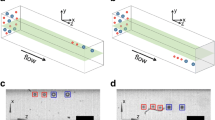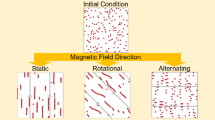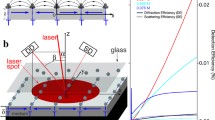Abstract
We demonstrate the influence of experimental conditions (carrier fluid viscosity and particle–wall interactions—friction) on the quasi-2D deterministic aggregation kinetics of carbonyl iron magnetic suspensions in rectangular microchannels. On the one hand, the carrier fluid viscosity determines the time scale for aggregation. On the other hand, friction strongly determines the aggregation rate and therefore the kinetic exponent (mean cluster size vs. time dependence). When particle–wall interactions are weak, the mean cluster size increases with a power of 0.65 ± 0.06, for open cavities (≥500 microns channel width), in very good agreement with theories and particle-level simulations. However, when the particle–wall interactions are strong, the kinetic exponent decreases and the aggregation is eventually arrested. This work suggests that particle–wall interactions may be one of the reasons for the discrepancies found in the experimental determination of the aggregation kinetic exponents in the literature.






Similar content being viewed by others
References
Banerjee U, Bit P, Ganguly R, Hardt S (2012) Aggregation dynamics of particles in a microchannel due to an applied magnetic field. Microfluid Nanofluidics 13(4):565–577
Bombard AJ, Gonçalves FR, Morillas JR, de Vicente J (2014) Magnetorheology of dimorphic magnetorheological fluids based on nanofibers. Smart Mater Struct 23(12):125013
Černák J, Helgesen G (2008) Aggregation of magnetic holes in a rotating magnetic field. Phys Rev E 78(6):061401
Černák J, Helgesen G, Skjeltorp AT (2004) Aggregation dynamics of nonmagnetic particles in a ferrofluid. Phys Rev E 70(31):031504
de Vicente J, Klingenberg DJ, Hidalgo-Alvarez R (2011) Magnetorheological fluids: a review. Soft Matter 7(8):3701
Domínguez-García P, Melle S, Pastor JM, Rubio MA (2007) Scaling in the aggregation dynamics of a magnetorheological fluid. Phys Rev E 76(5):1–13
Domínguez-García P, Pastor JM, Rubio MA (2011) Aggregation and disaggregation dynamics of sedimented and charged superparamagnetic micro-particles in water suspension. Eur Phys J E 34:1–7
Erb RM, Son HS, Samanta B, Rotello VM, Yellen BB (2009) Magnetic assembly of colloidal superstructures with multipole symmetry. Nature 457(7232):999–1002
Fernández-Toledano JC, Rodríguez-López J, Shahrivar K, Hidalgo-Álvarez R, Elvira L, Montero de Espinosa F, de Vicente J (2014) Two-step yielding in magnetorheology. J Rheol 58(5):1507–1534
Fraden S, Hurd AJ, Meyer RB (1989) Electric-field-induced association of colloidal particles. Phys Rev Lett 63(21):2373
Gijs MAM (2004) Magnetic bead handling on-chip: new opportunities for analytical applications. Microfluid Nanofluidics 1(1):22–40
Helgesen G, Skjeltorp AT, Mors PM, Botet R, Jullien R (1988) Aggregation of magnetic microspheres: experiments and simulations. Phys Rev Lett 61(15):1736–1739
Koser AE, Keim NC, Arratia PE (2013) Structure and dynamics of self-assembling colloidal monolayers in oscillating magnetic fields. Phys Rev E 88(6):1–6
Lee JT, Abid A, Cheung KH, Sudheendra L, Kennedy IM (2012) Superparamagnetic particle dynamics and mixing in a rotating capillary tube with a stationary magnetic field. Microfluid Nanofluidics 13(3):461–468
Melle S, Calderón OG, Rubio MA, Fuller GG (2003) Microstructure evolution in magnetorheological suspensions governed by Mason number. Phys Rev E 68(4):41503
Nguyen NT (2012) Micro-magnetofluidics: interactions between magnetism and fluid flow on the microscale. Microfluid Nanofluidics 12(1–4):1–16
Otsu N (1975) A threshold selection method from gray-level histograms. Automatica 11(285–296):23–27
Promislow JHE, Gast AP, Fermigier M (1995) Aggregation kinetics of paramagnetic colloidal particles. J Chem Phys 102(13):5492
Reynolds CP, Klop KE, Lavergne FA, Morrow SM, Aarts DG, Dullens RP (2015) Deterministic aggregation kinetics of superparamagnetic colloidal particles. J Chem Phys 143(21):214903
See H, Doi M (1991) Aggregation kinetics in electro-rheological fluids. J Phys Soc Jpn 60(8):2778–2782
Shahrivar K, Carreón-González E, Morillas JR, de Vicente J (2017) Aggregation kinetics of carbonyl iron based magnetic suspensions in 2D. Soft Matter. doi:10.1039/C7SM00075H
Vicsek T, Family F (1984) Dynamic scaling for aggregation of clusters. Phys Rev Lett 52(19):1669
Wang Z, Shahrivar K, de Vicente J (2014) Creep and recovery of magnetorheological fluids: experiments and simulations. J Rheol 58(6):1725–1750
Zhang Y, Nguyen NT (2017) Magnetic digital microfluidics—a review. Lab Chip 17(6):994–1008
Acknowledgements
This work was supported by MINECO MAT 2016-78778-R, MAT 2013-44429-R and PCIN 2015-051 Projects (MINECO and FEDER, Spain), European Regional Development Fund (ERDF), by Junta de Andalucía P11-FQM-7074 Project (Spain) and CONACYT (Grant No. 232347).
Author information
Authors and Affiliations
Corresponding author
Rights and permissions
About this article
Cite this article
Shahrivar, K., Carreón-González, E. & de Vicente, J. On the importance of carrier fluid viscosity and particle–wall interactions in magnetic-guided assembly of quasi-2D systems. Microfluid Nanofluid 21, 120 (2017). https://doi.org/10.1007/s10404-017-1955-y
Received:
Accepted:
Published:
DOI: https://doi.org/10.1007/s10404-017-1955-y




